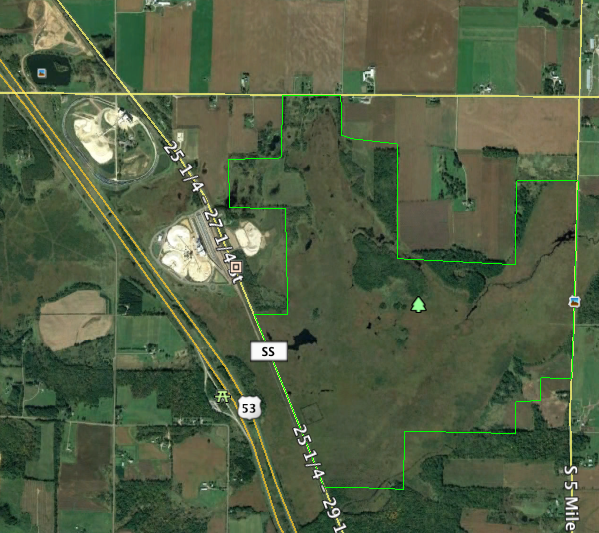An Optical PM monitor can be used to take a qualitative survey of the relative PM levels near a source of rock dust, potentially identifying areas of relatively high PM, known as a PM hotspot.
One place where such a survey could be conducted is in the the New Auburn, WI Wildlife Area, which surrounds three sides of the Great Northern Sand Mine in the town of Dovre.
My questions are:
- Is it worth surveying near this mine? is anyone interested?
- Can we access the land within the Wildlife Area to take measurements? While we can legally access the land as a park, its not clear that the area will be above water.
- Can we access the land in the spring?
New Auburn Wildlife Area Access
I knew of the mine through discussions with a Barron County resident, and found it on the Wisconsin DNR's map of sand facilities.
While the state's park map shows access and parking areas, it shows no formal paths:
In the USGS Topo Quadrant downloaded through the National Map viewer, the area is marked with topographic symbols for partially submerged woodland swamp:
Does anyone with local knowledge know what the area is like in spring? I expect significant seasonal variation.
Area winds
On windhistory.com I was able to find a nearby wind plot in Rice Lake. It seems SE are prevail around the mine. The Wildlife Area is usually downwind of the mine:
Potential hotspot survey method
I'd like to try out the methodology detailed in the link above by Ott et al. in:
Passive sampling to capture spatial variability in PM10–2.5 Darrin K. Ott, Thomas M. Peters, and Naresh Kumar Atmospheric Environment 42 (2008) 746–756
Over four days, Ott et al. toured 60 sites in Iowa City with an optical PM monitor, taking 6 minutes of measurement at each site. The result was a hotspot map they used to deploy passive pm monitors for quantitative measurement.
While a qualitative survey with an optical PM monitor did not prove unsafe levels of PM, it did demonstrate a downwind hotspot.





@marlokeno pointed me to the US Dept. of Labor's Mine Data Retrieval System which indicates that Great Northern is currently abandoned.
This is an interesting point, because an abandoned mine should be under active dust suppression and on its way to reclamation.
Reply to this comment...
Log in to comment
Matthew: Please look again at the "Current Mine Information" you posted with your question. It has "Opr. Begin Date" of 6/1/2013 for Hoffman Construction Company and Great Northern Sand as operator begins on 5/3/2012 and ends on 5/31/2013. So the site changed operators with Hoffman Construction seemingly still operating;( maybe not as a mine?) Also, the Wisconsin DNR data for PM10 monitoring, http://dnr.wi.gov/topic/Mines/AQSandMap.html, shows monitoring data for Great Northern from 10/26/14 through 12/26/16 without a note stating that "sampling ended" as it has for some other sites. So, the situation is not as straight forward as it might have seemed at first sight. In addition, around here, "wildlife area" often indicates marginal land that is marshy and/or overgrown and left for hunting and trapping. If the winter had much snow, spring could be very muddy and/or wet and there are often a lot of brambles. jeff falk
Is this a question? Click here to post it to the Questions page.
Reply to this comment...
Log in to comment